… here in the Northern hemisphere, Soon the trees will start to change color (in some combinations of altitude and water table, some of the maples have already started). And we shan’t otherwise be posting today, but will be back on the job on Monday.
Saturday Matinee 035: The Deserter
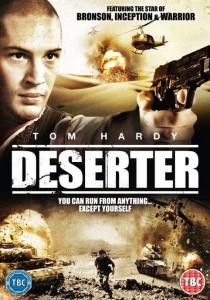 We’re going to begin this review with a spoiler, because we waited the whole damn movie for the protagonist to desert, and he never does. So why is the movie called The Deserter? Because secondary characters do, and they can’t use the name of the book the movie dramatizes: it’s called The Legionnaire, and that was the name of a less-bad-than-you’d-expect Jean Claude van Damme show that we’ve already reviewed in this series.
We’re going to begin this review with a spoiler, because we waited the whole damn movie for the protagonist to desert, and he never does. So why is the movie called The Deserter? Because secondary characters do, and they can’t use the name of the book the movie dramatizes: it’s called The Legionnaire, and that was the name of a less-bad-than-you’d-expect Jean Claude van Damme show that we’ve already reviewed in this series.
What it is, is a movie about a 19- or 20-year-old Briton in 1960 who tells a young lady rejecting his advances that if she won’t marry him, he’ll run off and join the French Foreign Legion. We open in Marseille; at the same caserne, in fact, where van Damme’s character joins up to flee other complications. Young Simon Murray is in a dressy double-breasted suit, carrying a briefcase, as he is handed a huge stack of paper. “Sign here.” He does, and he’s the property of the Legion Étrangère, although not yet a Legionnaire. That title, you see, must be earned, and Murray and his raggedy fellows are greeted by the hardened caporal and sergent-chef at Mascara in Algeria with skepticism — and cruelty.
The Legion’s training was never new-agey, and in those days it was brutal, featuring corporal punishment, muscle failure PT, obstacle courses seemingly designed by that French luminary, le marquis de Sade, the pelote (a Legion-specific evolution involving a ruck full of rocks and duckwalking), and did we mention corporal punishment?
Along the way, the new recruits bond and enjoy, occasionally, trying to put one over on the NCOs. Sometimes they succeed, sometimes not. (What are they going to do, beat you? They were going to do that anyway). As happens in military training, the Dear John letters come streaming in and the boys begin to harden into men. But there’s no overstating the harshness of Legion life.
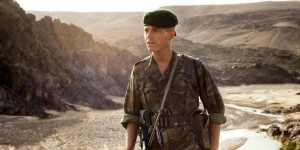 There is not much attention to weapons training on screen but all of the Legionnaires are shown to be proficient with the MAS 36 rifle, the MAT 49 SMG, M1935A and 1935S pistols, the M1919 Browning LMG, and mortars. Some of the weapons are correct for the unit and the period, some are not, and the vehicles are all wrong, suggesting that the exteriors were shot nearer to LA than Algiers: M151 jeeps and M35 2 1/2 ton trucks, and a very out-of-place M60 series tank, amusingly labeled (in French) “Friday the 13th.”
There is not much attention to weapons training on screen but all of the Legionnaires are shown to be proficient with the MAS 36 rifle, the MAT 49 SMG, M1935A and 1935S pistols, the M1919 Browning LMG, and mortars. Some of the weapons are correct for the unit and the period, some are not, and the vehicles are all wrong, suggesting that the exteriors were shot nearer to LA than Algiers: M151 jeeps and M35 2 1/2 ton trucks, and a very out-of-place M60 series tank, amusingly labeled (in French) “Friday the 13th.”
The film’s low budget ($3.5 million, ten years ago) comes shining through at times. At one point, some genius of an armorer or set dresser has mounted an M1919A4 upside-down in the pintle, its pistol grip reaching for the sky in rigor mortis, the dying cockroach of machine guns.
Likewise, the men are supposed to be members of the 2e REP and display para badges and regimental crests once they graduate from training, but are never shown undergoing any airborne training. This is likely a function of the budget. They did budget enough gasoline for big, fake explosions, but unfortunately there is more jaw-jaw than war-war. It’s a bit too true to life that way: “hurry up and wait” is great for verisimilitude, but not so much for drama.
Simon meets interesting characters including a pair of French ladies (one of whom seems to fill the gap in his heart left by the Dear John news), an Arab tea merchant and a world-weary mullah who dreams of an end to the war so his young students will come back from the hills.
At times the film gets politically correct and anachronistically preachy, and at one point we were ready to give up on the film as too Hollywood and hopelessly fake. So we paused it and went to a bookstore, where we found the book The Legionnaire, and discovered to our shock and awe that Simon Murray is a real person (the film reveals this at the end) and that he actually kept a diary, upon which book and movie are based.
As the forces of the FLN (pro-independence terrorists and guerrillas) fought the pieds-noirs (Algeria-born Frenchmen) and OAS (Secret Army Organization, anti-independence terrorists and guerrillas), many of the Legionnaires, like many of their leaders, have divided loyalties.
History fans probably know the story of how De Gaulle resolved to grant Algeria independence, only to meet violent resistance from the OAS and an attempted coup by military officers. Simon faces the decisions a private soldier in an army in rebellion must always face: be loyal to flag, or to unit and leaders? And he gets some good advice from the tough French lieutenant he admires.
Some soldiers stay with the unit, some rebel and join the OAS, bad things befall Simon’s friends French and Arab alike, and the situation resolves with more drama than the sometimes lagging storyline led us to expect.
The DVD credits Tom Hardy (bad guy Bane in the recent Batman film) first, but he plays the foil, Dupont; Simon Murray is played (and very well, indeed) by Paul Fox. The rising popularity of Hardy has driven the DVD release, but we did find it in the $5 bin, so he only drives it so far.
At the end of the movie, we liked it rather better than in the flagging middle. The best scenes opened us up to the film a little: when Simon confesses to his recruit buddies that he told his girlfriend Jennifer, who is now going to marry some other guy, that he told her if she wouldn’t marry him he’d join the Legion. “You’re truly a man of your word!” one of his friends howls. The scene of the recruits’ initiation in the Legion, and their presentation of the kepi blanc, is extremely well done. By that time we’ve seen these young men transformed from rabble in ill-fitting fatigues to clean and proud Legionnaires.
With the movie over, and knowing it was based on a true story, we had to look up Simon Murray and see what became of him in later life. We were pleased to discover he is still alive, a success both as a businessman and an adventurer, and still married to his first wife, who, through a remarkable coincidence, we had met some years ago while she, an adventurer in her own right, was doing some daring things.
It’s truly a small world. As to the movie — not the best (for the record, Legion vets speak well of 1939’s Beau Geste and March or Die with Gene Hackman), not the worst, well worth the $5 in our book.
Three Nations’ Military Pistol buys through World War II
There were some interesting figures mentioned in passing at the end of the chapter on Japanese wartime pistols in Ezell’s Handguns of the World. The statistics were interesting enough that we thought we’d parse them out and expound on them a wee bit. Because, you see, different nations gave pistol production entirely different priorities during the war and in the very long period leading up to it — for Ezell started counting in 1875. So how many pistols did three world powers buy for their armed services in the seventy years from 1875 to 1945?
|
Nation |
Pistols & revolvers bought, 1875-1945 (estimated) |
| Germany | 6 million |
| United States | 3-4 million |
| Japan | 400,000-500,000 |
Source: Ezell, Edward Clinton. Handguns of the World, Harrisburg, 1981: Stackpole Books. p. 626.
Interesting. Unfortunately we don’t have figures for the British Commonwealth and the USSR.
There are a number of factors involved. Ezell suggests that the Japanese did not emphasize pistols, while the other nations’ services did. (The Imperial Japanese services were also smaller than the American or German armies). He further suggests that this lack of emphasis may be why Japanese handguns — how shall we put this politely? — fail to achieve world standards. The Japanese also had the least handgun variety of any of the major powers. (They also had less penetration of pistol-caliber submachine guns in their armed forces than any of the other belligerents; they had a functional if plug-ugly and hard to manufacture SMG in the Type 100, but it never seemed to catch on).
Japan also seems to have required its officers to purchase their own sidearms, or do without. The other nations generally issued pistols. Pistols were seldom carried by anyone but officers in the Japanese Army and Navy. And officers seemed to prefer, as a badge of rank, the traditional Japanese sword. Cavalrymen, heavy-weapons and artillery crews, and paratroops were generally supplied with bolt-action carbines or even full-length rifles.
In the German service, those special-purpose troops were generally armed with pistols, and sometimes they were the only weapon carried by officers, even in ground-conbat units. Senior officers particularly wore pistols, often personally-owned small pocket pistols, as a token and privilege of rank. All German paratroopers carried pistols on airborne operations (Crete being the largest and best-known in the West) because all their long arms were dropped separately, in canisters. (Gliderborne forces, an important part of the German airborne, kept their rifles and MPs with them).
As a result, German demand for pistols during the war was insatiable, with numerous captured weapons and even captured production lines being pressed ino service. This was true not only of weapons that were already in or readily convertible to fire Germany’s standard 9mm cartridge, but also of many other handguns in a wide range of sizes and form factors. So while Germany could put 9mm Browning High Powers and Radom VIS’s to work right away in their existing logistic system, they also used a wide variety of .32 and .380 pistols, and even the 7.65mm French Long M1935 pistols. We’ve even seen 9mm Largo Spanish guns with documented and credible Nazi provenance. This must have been irritating for German logistical planners.
The USA fit midway between German enthusiasm for and Japanese disinterest in pistols. Our paratroops armed themselves as heavily as possible, and a .45 was never more than a secondary weapon. We had, prior to our war entry, developed what is today called a personal defense weapon to increase the range and lethality of crews’ and officers’ defensive armament. Many officers disdained the concept of pistol armament for leaders, and supplemented that with a rifle or carbine.
Cops shoot bystanders. Why?
NYPD pistol qualification. Two cops engaged the bad guy from closer than this. They did kill him, but most of their rounds missed, and they wounded nine luckless citizens. Image: NYPD Firearms Training Committee
Nine bystanders are recovering after having been wounded, apparently, by NYPD officers in the vicinity of the Empire State Building. The cops were trying to stop a murderer who pulled a gun on them, but apparently, didn’t get a shot off.
The cops did succeed in hitting the killer with seven of 16 shots, at a distance police officials reported as eight feet. The other nine rounds went wide, steaming into in the midtown throng. Some of the bystanders were hit by bullets directly, but most of the wounds appear to have been from ricochet fragments and from shattered masonry. Some of the rounds appear to have been fired at, or into, the already-dead killer as he lay on the sidewalk, and the rabbit-rounds off the pavement were what sent so many New Yorkers to the hospital.
We use all the “appears” and “apparentlys” because, of course, we’re working off media reports (largely in the New York Times), and journalists are to reporting accuracy as NYPD patrolmen are to shooting accuracy: they hit the mark at point-blank range nearly half the time.
This is pretty typical of NYPD shooting — essentially, most of the time missing the equivalent of the paper at a range of under three paces, with a handgun a trained marksman can hit e-type silhouettes at 100 meters with.
There’s no question in our mind that the two officers were right to shoot. A witness identified a suspect and said he had seen the suspect shoot a man dead. The police cautiously approached the suspect. He instantly pulled a Star .45 on them. It’s hard to imagine a situation that’s a more righteous shooting, and the cops are to be applauded for their speedy reaction and for sparing the citizens of the Empire State the tedium and expense of a trial and decades of incarceration of this clown. But where they departed from righteousness is in their marksmanship, which was dreadful.
We’re seeing a lot of excuse-making around the net (and coming from the Times, and police spokesmen): adrenaline, fear degrading performance, combat shakes, etc. We call bullshit. Combat shakes are real, but you get them after you kill the guy, not while you’re doing it. If your training has been thorough enough and your stress-inoculation deep and broad, you’ll shoot people just as well as you shoot bull’s-eyes. If you’ve been trained to assume there’s always a solid backstop when you fire, you’ll ventilate whatever’s downrange from the bad guy. QED.
The killer was a fashion designer who shot one of the executives of the company that had just sacked him. He was probably pretty emotional when he blew the luckless vice-president away, but he didn’t hit anybody but his intended target. If a scum-of-the-earth murderer can do it, why can’t the NYPD?
Well, maybe it’s their lame training. A police recruit gets 13 days of weapons training in the Academy. After that, he had to go to the range twice a years and qualify. He never gets any meaningful instruction on what bullets do when they hit various backstops — like a sidewalk. He never gets any meaningful instruction on when to stop shooting, only to “keep shooting until the threat is gone.” Nobody ever really shows or tells him about the wide range of human reactions to gunshot wounds.
But then, you try training these guys. It’s a big job and an expensive one: the department has 35,000 cops which means 70,000 qualification shoots a year, not counting initial instruction for rookies. Every officer not on patrol (i.e., assigned as an instructor) must be justified in a time of tight budgets, and every cartridge expended has to be sold to green eyeshades and white shirts as a necessary expenditure.
As a result, the instructor-student ratio and the time available for training is not — can not be — what we got used to in Special Forces, for example (and we don’t shoot as much as the SEALS!). All that said, this shooting took place at under three paces. Stop and pace that off before coming back to your screen. The police did not hit with over half their shots at that range, against an assailant who did not get a shot off, and they hit nine people who were not targets.
Yet Mayor Bloomberg, his stuffed white-shirt of a police commisar, and the biens pensants at the Times, all think this was exemplary and there is no room for improvement. In their own hearts and minds, the two cops who were involved know that’s not true. You and I know that’s not true. At some level, even Bloomberg and all know it’s not true.
The police performance here was D+. A dead citizen would be an F, and they didn’t kill a citizen, which raises them to D, and they didn’t let the criminal endanger anyone, which nets them a plus. New York can’t afford to buy A-level marksmanship, across a force the size of the 18th Airborne Corps, we get that. They’re getting better at terminating engagements, too: most readers probably remember the Amadou Diallo case where several cops mag-dumped on a guy who turned out to be entirely innocent (and their marksmanship has improved since then… they were at about 15% hits on Diallo). Both of these guys stopped shooting before they locked back. But the bosses’ smug satisfaction in the performance of this barely-passing shooting bodes ill for further improvements.
Despite all that, we can trust Thomas Kaplan of the New York Times to get right to the bottom of it. Turns out the horrible carnage was caused by — the deadly power of a cheap Spanish knock-off of the GI .M1911A1 pistol. The suspect bought a Star .45 in Florida in 1991, and Kaplan is mesmerized by one of “the more lethal handguns on the American firearms market.” Kaplan seems to be arguing that, if Florida had strict gun bans like New York’s (even though the New York ban is selectively enforced, and charges seldom laid against violent criminals who bust gun laws en passant), why, they’d be free of murders like New York is…oh, wait. Well, that’s the theory, anyway. If it were even possible, one supposes that Kaplan would applaud the fact that the only shooting victims would be the ones shot by the police. Mind you, that would still be more people than get shot in Miami, total.
Gun Used in Shooting at Empire State Building Is Known for Its Deadly Power – NYTimes.com.
A wag once observed that the usual aftermath of a media-circus shooting is liberal statists (if the shoe fits, Kaplan, Bloomberg) calling for a crackdown on the people that didn’t do it. Yet again, QED.
Cop killer’s gun acquisition under investigation
It was a typical small-town, small-time criminal case. Cullen Mutrie had once wanted to be a cop or firefighter but had had increasing numbers of brushes with the law, mostly for beating up girlfriends, using steroids and other penny-ante drug activity. Now Mutrie was selling drugs again — oxycodone, an informant told the cops.
It was the last tough case that Greenland, NH police chief Michael Maloney wanted to get out of his in-box before he retired. He wanted to leave the new chief a clean desk, and picking up Mutrie, who’d always come along in the past, would tie up the transition in a nice little bow.
It didn’t work that way. Mutrie, for reasons we’ll never know, wasn’t going quietly: he met Maloney and officers from a regional drug enforcement task force with a barrage of gunfire. Four cops were wounded. Maloney was killed when he left cover to pull one of the wounded to safety. Sometime during the standoff that followed, Mutrie executed his girlfriend and accomplice, Brittany Tibbets, and then killed himself.
The crimes shocked the quiet New Hampshire Seacoast region. A few miles away, the adjacent town of Rye has been roiled by … nasty letters to the editor from road-hog bicyclists and angry motorists. Drugs and shootings, let alone cop-killing, don’t seem to “belong.”
In the aftermath of the violence, this question arose: as Mutrie was forbidden to own guns under the Lautenberg Amendment, how had he managed to rearm himself? His history of beating girlfriends led to several domestic violence charges, and, in July 2010, to the police arresting him and confiscating the guns in his house, a property his mother owned where he lived without any visible legal means of support. He’d once dreamed of being a firefighter, but that dream life apparently couldn’t compare to life in a run-down house on the fringes of society — but enhanced by drugs.
The wounded police officers, suing Mutrie’s mother (based apparently on rumors she has assets), have floated the story (without providing evidence) that Mutrie’s guns came from his mother. Now, for the first time, the authorities have spoken on the record about the original sources of Mutrie’s guns.
A 9mm pistol found at the scene where Cullen Mutrie shot five police officers, wounding four and killing Police Chief Michael Maloney, has been traced to Mutrie’s father, said Associate Attorney General Jane Young.
Mutrie had been barred from possessing weapons since his arrest for domestic assault in 2010. According to Young, the 9mm pistol found in his home after the April 12 shootings was sold in May 1989 to his father, Charles Mutrie, who died Jan. 10, 2010.
“I don’t know at this juncture how (Cullen Mutrie) got that weapon,” Young said.
The associate attorney general said she was also unsure if Mutrie’s mother Beverly knew her son had her late husband’s pistol.
It’s possible that Mutrie only obtained the gun after the cops seized the guns he owned in 2010. It’s also possible that he had it all along and successfully hid it; his domestic violence arrest came seven months after his father’s death. The provenance of the other gun found near Mutrie’s and Tibbets’s dead bodies is crystal clear, though.
Young previously said a second gun found at the scene, a .357 revolver, was bought in January at a Manchester gun show by Brittany Tibbetts, who was allegedly selling drugs with Cullen Mutrie from the Post Road residence where the shootings occurred. According to the attorney general’s office, after Cullen Mutrie shot the officers, he fatally shot Tibbetts, then himself.
via Cop shooter had deceased dad’s pistol, says AG | SeacoastOnline.com.
The paper which we’re citing here has used this as an example of the “gun show loophole” in action, but of course, it wasn’t. We have no way of knowing whether Tibbets knew Mutrie was DQ’d, and no way of knowing if she bought the gun for him or for herself. The degree of her involvement in his crimes is unclear even now, and despite the criminals’ being dead, the authorities have been extremely parsimonious with information, possibly to aid the cops’ lawsuit.
But Tibbets bought the .357 perfectly legally from a dealer, not a private seller, and passed a State of NH records check (which includes the FBI instant check plus the state disqualified-persons list, which had Mutrie, but not Tibbets, on it) at the time. If her intent was to give the gun to Mutrie (as seems probable) then she was committing a crime, but that didn’t deter her much as she was already a partner of some kind in the drug trafficking conspiracy.
Her error, of course, was to expect anything but crime, violence and mistreatment from a jerk whose history was one of crime, violence and mistreatment of his women, but to certain women that kind of male behavior is a concentrated aphrodisiac. Extremely poor judgment on her part, but it’s possible to have a smidgen of sympathy for her.
Until you think about Chief Maloney and how her actions and Mutrie’s punished the good chief for his impulse to duty. Think about that, and your only wish for Mutrie and Tibbets is that they burn in hell.
In any event, this case illustrates how a criminal like Cullen Mutrie can leverage his personal relationships to gun up when the law is happy in false confidence that they have disarmed him.
UPDATE, sort of: the MAC-11 toting crim from the same small New Hampshire town (whom we covered earlier this week in “Blaster from the Past”), had three bizarre connections to this case. First, he told friends he was going to shoot cops rather than be taken in (unlike Mutrie, he didn’t, but went quietly. Just goes to show you can’t trust what a crim says). Second, he told those friends that Mutrie “should have shot more cops.” Third — and here’s where the small scale of the New Hampshire seacoast really appears — turns out that the slain Chef Maloney was the would-be cop-killer’s ex-father-in-law.
Is that about as weird as it gets?
LLAD: Your tax dollars down the VA rathole
Here’s “General George S. Patton Jr.” telling personnel clerks for the VA how important they are, interspersed with personnel clerks and extremely-highly-paid managers of personnel clerks talking about (can you guess?) how important they are.
Repeat after us: The VA clerks are the bravest, kindest, warmest, most wonderful human beings we’ve ever known.
Lord love a duck! Would you pay over $50,000 for that video? Ha! Trick question. If you’re a taxpayer, you already did.
But that’s just the visual punchline to this sick joke which is, alas, dear taxpayer, on you. The video was made for a VA conference for which its personnel clerks spent a week at a vacation an offsite conference (doesn’t that sound better?) in the family playground of Walt Disney World the very serious business city of Orlando, Florida. But VA’s so big they couldn’t fit everyone in one conference so they held a second one the next month, with many of the same higher-ups kicking back and goofing off displaying supreme bureaucratic leadership at both conferences.
It’s unclear whether the $5 million plus bill was for both conferences, or for each. (Does it matter? It is only the difference between monstrosity and enormity). We do know about the $52k spent on the above short film, which must have the original Patton beating on the lid of his sarcophagus and threatening blue murder if he can get out. And we know about the $84k spent on custom-labeled souvenirs like coffee cups and pens. In all, this VA clerks-gone-wild party conference wasted seven to fifteen times as much as the GSA boondoggle that was in the news a few cycles ago.
Exit question: is the VA run for the benefit of the troops, or the benefit of the employees? Exit clue: the department is headed by Rick Shinseki, whose sole lasting accomplishment as Chief of Staff of the Army was the social promotion of every cook, clerk and combat messkit repair specialist to the black beret that was formerly the mark of a Ranger.
HR Professionals (“no, seriously, what’s your real job?”) lead the way. Hooah.
Mystery Gun Unmasked
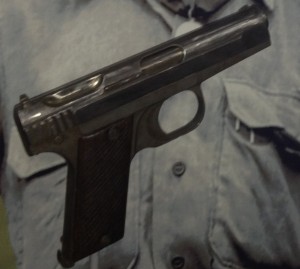
What is it? No longer a mystery thanks to an 18Z who kept his Bravo skills sharp, it’s an 8mm Hamada Type II — the rarest of all Japanese WWII handguns.
It had us stumped, which is really pretty hard to do. So we asked Ian at Forgotten Weapons. Ian is to rare, obscure and downright weird military guns of all nations and eras as the Crazy Cat Lady is to “just one more adorable kitten” — but it beat him with a stick, too.
OK, here’s something that’s on display in the Special Forces Branch Museum on Ft. Bragg… this gun is featured there, in a display on the OSS Detachment 101 war in Burma against the Japanese.
Best guess is some kind of homemade, jungle workshop weapon. (Ian at Forgotten Weapons made a similar guess, but an exact ID on this piece eludes him, too. If a gun beats us and Ian, then it’s something seriously weird).
via What is it? « WeaponsMan.
It was unlabeled in the museum, it turns out, because they had no idea what it was, either. But one of their experts came through, as USASOC’s Rodney Cox posted in the comments to that post recently:
As only 1500 of these were actually made it is no wonder that it was so difficult to ID. The reason it was the only weapon on display at the museum without a discription is that we couldn’t ID it either. Thanks to MSG (ret) Tommy Galbaith, we now know it is a Japanese Type II Hamada chambered in 8mm Nambu. Said to be a copy of the Browning M-1910 designed by Bunji Hamada. Hope this helps, and thanks to all for your interest the museum.
We hit the net for some more information, not having a reference work on Japanese pistols (the Hamadas are too rare to figure in Small Arms of the World). We found some auctions of the earlier Type 1 which was in 7.65mm Browning (.32 ACP). Here’s one. Its familial resemblance to (and similarly crude manufacture to) the weapon in the museum is clear, as is its Browning provenance.
Hamada and Son Ltd. is still in business — as, unbelievably, a vendor of extremely fine shotguns.
UPDATE: To our embarrassment, we already had information on the Hamada Type II on our shelf, although, to be sure, it was very limited information. Ezell’s Handguns of the World, a comprehensive reference from the early 1980s which we suspect to be now out of print, has a brief mention of the Hamada guns on page 626. They’re also included in a statistical table on Japanese pistols on the same page, and pages 627 and 628 are full-page photos of the Type I and Type II respectively. Interestingly, the weapons in the book seem to be much better finished that the SF Museum Type II or the auction Type I cited in this post. Next time we have an old military whatsis, we’re going straight to Ezell….
Human targets? Lord love a duck.
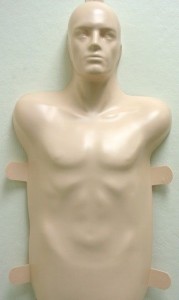 If we hadn’t seen it with our own eyes, elsewhere, in the past, we might have thought that Jason Hanson was making things up. We were checking USA Carry preparatory to a road trip (“where do we need to case the gun and trust to blind luck?” is answered by their reciprocity maps) and we saw this article of his:
If we hadn’t seen it with our own eyes, elsewhere, in the past, we might have thought that Jason Hanson was making things up. We were checking USA Carry preparatory to a road trip (“where do we need to case the gun and trust to blind luck?” is answered by their reciprocity maps) and we saw this article of his:
And the other day while I was inspecting one of the ranges the gentleman who was showing me around said, “You don’t use targets that show real people do you?” I explained to him that I use several different targets throughout my courses and some of them are indeed human-like.
He then got a frown on his face and said, “we do mainly hunter education here and we don’t like to encourage people to shoot other people so we don’t want human-like targets on the range.”
When he said that, I almost laughed out loud thinking he was deadpanning some comedy routine, but when I realized he was serious I simply said “okay” and left.
Now, we don’t know Hanson, whether he can instruct his way out of a paper bag, or whether his bio is accurate, or anything. (We’re not calling any of that into question, just underlining the fact that we do not know him from Adam and have never seen his byline before). But we see two diferent problems here. One is the obvious one: he ran into a Fudd or a nest of Fudds that are not on board with armed self-defense. The second is less obvious, and we want to raise it here: human-shaped targets are not as necessary as people think. At some stages of instruction they’re actually counterproductive.
Before we continue, let’s address one particular point with some vigor:
I do realize there are a lot of ranges and even states that don’t allow human-like targets. (I don’t know if this true, but I was once told that the state of Massachusetts did not allow human targets.)
We were apalled to see speculation like this on a site that is all about providing accurate gun law information. It shakes my confidence in the accuracy of the site as a whole… reminds me of the forum where someone,wondering about a detail of carry law in his state, was advised to ask around at gun shops. Hayzoose Marimba. That’s a great way to get a firm, strongly-expressed opinion… which is as likely to be correct as a toss of a six-sided die. To know the law you have several options: 1, ask a lawyer in that state and that area of practice, and pay his bill (if you didn’t pay for it it’s not legal advice you can count on); 2, ask a certified and current CCW instructor (this has pros and cons vis-a-vis the lawyer. Good CCW instructors are up on state laws and, just as important, on how the local gendarmes interpret the law, but not all CCW instructors are good like that), and 3, read the law yourself (this is the least desirable method, because black-letter law is laden with term-of-art land mines and case-law-interpretation-reversals compared to common-sense English).
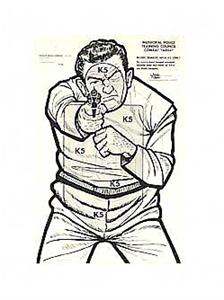 For the record, Massachusetts does ban human-representation targets, in narrow circumstances. A licensed club or range “shall not permit shooting at targets that depict human figures, human effigies, human silhouettes or any human images thereof, except by public safety personnel performing in line with their official duties.” Most clubs and ranges don’t hold that form of license. Of course, most police don’t know the law and operate on the principle that “you may beat the rap but you can’t beat the ride.”
For the record, Massachusetts does ban human-representation targets, in narrow circumstances. A licensed club or range “shall not permit shooting at targets that depict human figures, human effigies, human silhouettes or any human images thereof, except by public safety personnel performing in line with their official duties.” Most clubs and ranges don’t hold that form of license. Of course, most police don’t know the law and operate on the principle that “you may beat the rap but you can’t beat the ride.”
And yes, we asked a lawyer, and he pointed us to the exact verbiage in the Massachusetts General Laws, and indicated that there’s no case law on this (meaning no one appears to have ever been charged and resisted. He advised us not to violate the law and become the first). In his opinion the intent of the law was to “chill” an entrepreneur who was making targets with the faces of various Massachusetts politicians on them, as well as the ever popular image of a 1960s starlet much disliked by Vietnam veterans. As a matter of Massachusetts law, the targets aren’t illegal and shooting as many paper Kennedys as you like is legal (if gauche), unless you’re at a range that has a range handgun license.
Now, if you can shoot at realistic targets, should you? They have some pros: they can be fun (take that!) and they can help people adjust to the idea that in a defensive shooting, it’s humans they’ll be shooting at, not bullseyes or bowling pins. But they have some cons, apart from their generally higher costs.
The theory behind realistic human targets is based in part on false information
Realistic human targets are used in training, in part, because of a seminal operational research report that was later published commercially as Men Against Fire. In it, historian S.L.A. Marshall reported the counterintuitive finding that most infantrymen in combat did not fire their weapons.
The problem is, Marshall not only never closed the gap between his dishnosis and prescribed remedy, he didin’t even gather the data that he claimed to. It emerged after his death that there was no systematic set of combat-interview data supporting his thesis. There were fewer interviews than he claimed, and they didn’t produce the results he wrote about. In other words, his principal finding, that men did not fire in combat, and his conclusion, that they could not bring themselves to shoot at human beings, and so needed to be socialized and accustomed to that by shooting at human-like targets, were and are unsupported. Logical, perhaps, but no evidence backs up the logic.
You can learn to shoot effectively at bull’s-eye targets
Some people don’t think you can learn to fire in combat effectively by practicing bull’s-eye marksmanship. Others differ. Firmly in the bullseye camp are the United States Marines, who teach marksmanship on known-distance ranges with round-bull’s-eye targets. Last time we checked, no one wanted to stand in front of a bunch of Marines and taunt them about their marksmanship.
You don’t necesarily learn better on human-shaped targets
The military and police generally teach a center-of-mass shot, but count any hit on the paper or on the silhouette as a hit. In an actual firefight, only disabling rounds count, and the area is much narrower and smaller than a classic GI E-type silhouette. (In this, the classic FBI target with its higher-scoring vital area is superior). But it’s hard to aim for the center of a silhouette unless you’ve had a lot of practice. In particular, shooters at the same level of experience have a lot more vertical dispersion on silhouettes than they do on a round bull’s-eye.
Seriously, to see how badly people shoot on silhouette targets, all you need to do is go back to Hanson’s article and look at the target he uses as an illustration. We don’t know who’s been shooting at that target, but he should be jolly glad it wasn’t shooting back.
This has nothing to do with guns
But it did make us laugh.
http://dog-shaming.com/
Now it’s your turn.
Heavy on the WWII German: this week’s gun books
The latest deliveries from the Big Brown Truck include the following:
From Collector Grade Publications
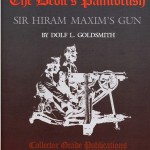 The Devil’s Paintbrush: Sir Hiram Maxim’s Gun by Dolf L. Goldsmith. The Maxim was the grandpappy of machine guns, and Goldsmith is the expert. This is a typically photo-rich, information-dense book from Collector Grade Publications. All in all there are 568 pages of Maxim facts including technical information and combat reports from the late 19th and throughout the 20th Century. Goldsmith points out things others take for granted, like the happy coincidence of the invention of the solid-drawn brass cartridge case arriving just in time for Maxim’s experiments with automatic weapons. (From today’s perspective, we tend to assume “it was always there,” but it most definitely wasn’t). This is a great book. If it has a failing, it is one that it shares with much of the Collector Grade line: poorly documented sources. (Not that it is poorly sourced; a great many primary documents grace its pages in facsimile. It’s just that a reader interested in following up has nowhere to go, but to contact Mr Goldsmith himself). Further, a non-fiction book automatically loses one star if it lacks an index, and the Collector Grade publications may be aimed at the true fanboy who will memorize the book, for none of them has an index.
The Devil’s Paintbrush: Sir Hiram Maxim’s Gun by Dolf L. Goldsmith. The Maxim was the grandpappy of machine guns, and Goldsmith is the expert. This is a typically photo-rich, information-dense book from Collector Grade Publications. All in all there are 568 pages of Maxim facts including technical information and combat reports from the late 19th and throughout the 20th Century. Goldsmith points out things others take for granted, like the happy coincidence of the invention of the solid-drawn brass cartridge case arriving just in time for Maxim’s experiments with automatic weapons. (From today’s perspective, we tend to assume “it was always there,” but it most definitely wasn’t). This is a great book. If it has a failing, it is one that it shares with much of the Collector Grade line: poorly documented sources. (Not that it is poorly sourced; a great many primary documents grace its pages in facsimile. It’s just that a reader interested in following up has nowhere to go, but to contact Mr Goldsmith himself). Further, a non-fiction book automatically loses one star if it lacks an index, and the Collector Grade publications may be aimed at the true fanboy who will memorize the book, for none of them has an index.
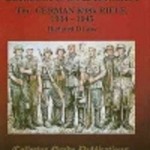 Backbone of the Wehrmacht: the German K98k Rifle 1935-1945 by Richard D. Law. What we said about “typically photo-rich, information dense book from Collector Grade Publications” applies here also. This is one volume of a multi-volume life’s work from collector and expert Law. Unless you are fascinated by Mauser 98 variations, there is much information here you will never need. However, there is also an amazing collection of original factory production information, not only the production figures by plant everyone’s curious about, and the plaintext breakout of Nazi war production codes, but also a description of the barrel-straightening machine (which seems to have combined an optical comparator with a hydraulic press), the Mauser-Werke’s assembly checklist, and cost accounting information. (There’s an MBA capstone, several of them in fact, in here for somebody). The same issues about sourcing apply, along with the sad note that Mr Law is deceased and not available to answer questions.
Backbone of the Wehrmacht: the German K98k Rifle 1935-1945 by Richard D. Law. What we said about “typically photo-rich, information dense book from Collector Grade Publications” applies here also. This is one volume of a multi-volume life’s work from collector and expert Law. Unless you are fascinated by Mauser 98 variations, there is much information here you will never need. However, there is also an amazing collection of original factory production information, not only the production figures by plant everyone’s curious about, and the plaintext breakout of Nazi war production codes, but also a description of the barrel-straightening machine (which seems to have combined an optical comparator with a hydraulic press), the Mauser-Werke’s assembly checklist, and cost accounting information. (There’s an MBA capstone, several of them in fact, in here for somebody). The same issues about sourcing apply, along with the sad note that Mr Law is deceased and not available to answer questions.
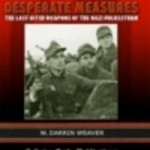 Desperate Measures: The Last-Ditch Weapons of the Nazi Volkssturm by W. Darrin Weaver. This book came to us highly recommended by Ian over at Forgotten Weapons and GunLab. It’s another Collector Grade tome, and the title describes the subject quite comprehensively. This Nazi militia used a mélange of obsolete, improvised/crudely manufactured, captured foreign, and standard issue German weapons in its ill-starred attempt to hold off what were, by this time, relentless war machines squeezing Germany from West and East. All these weapons are covered in a book that lavishes its most detailed examination on weapons produced specifically for the Volkssturm. Some of these showed remarkable ingenuity — and others showed nothing but a dying dictatorship going down hard and ugly. One of the more interesting things Weaver notes is that the Volkssturm, while almost completely ineffective in the West, was more of an obstacle to the Red Army. He ascribes this to the motivating nature of the East’s no-quarters combat. In dealing with the improvisations of a failing and soon-obliterated regime, documentary evidence is hard to come by but where it exists, Weaver seems to have found it. This book has a more thorough bibliography than the other Collector Grade tomes.
Desperate Measures: The Last-Ditch Weapons of the Nazi Volkssturm by W. Darrin Weaver. This book came to us highly recommended by Ian over at Forgotten Weapons and GunLab. It’s another Collector Grade tome, and the title describes the subject quite comprehensively. This Nazi militia used a mélange of obsolete, improvised/crudely manufactured, captured foreign, and standard issue German weapons in its ill-starred attempt to hold off what were, by this time, relentless war machines squeezing Germany from West and East. All these weapons are covered in a book that lavishes its most detailed examination on weapons produced specifically for the Volkssturm. Some of these showed remarkable ingenuity — and others showed nothing but a dying dictatorship going down hard and ugly. One of the more interesting things Weaver notes is that the Volkssturm, while almost completely ineffective in the West, was more of an obstacle to the Red Army. He ascribes this to the motivating nature of the East’s no-quarters combat. In dealing with the improvisations of a failing and soon-obliterated regime, documentary evidence is hard to come by but where it exists, Weaver seems to have found it. This book has a more thorough bibliography than the other Collector Grade tomes.
From Special Interest Publicaties
Man does not live by Collector Grade Publications alone. SI Publicaties from the Netherlands has the (English language) “Propaganda Photo” series that tells the story of particular Nazi weapons as told by official propaganda photo. While the photos are posed and their captions often phony, they do by definition depict the weapons in the hand of their original users. We added two books from this series this week.
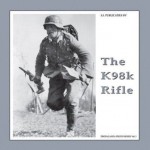 The K98k Rifle by Guus J. de Vries and Bas Martens is Volume I in the series and, as the title suggests, it covers the fundamental German individual infantry weapon of World War II, the Mauser 98 in its K98k World War II version. While the bulk of the book is, as promised, period propaganda photos, the book explains the history of the K98k, including all the main variations and some quite obscure and rare ones. It also addresses foreign Mausers which were widely pressed into Wehrmacht service. Rare variants like grenade-launcher hosts, Krummlauf shoot-around-corners barrels, and sniper 98s are also covered. For the generalist who wants to know about the K98k but isn’t obsessed with understanding every production change and every Bohemian workshop’s Waffenamt codes, this is a much better choice than the multivolume Richard D. Law set from Collector Grade.
The K98k Rifle by Guus J. de Vries and Bas Martens is Volume I in the series and, as the title suggests, it covers the fundamental German individual infantry weapon of World War II, the Mauser 98 in its K98k World War II version. While the bulk of the book is, as promised, period propaganda photos, the book explains the history of the K98k, including all the main variations and some quite obscure and rare ones. It also addresses foreign Mausers which were widely pressed into Wehrmacht service. Rare variants like grenade-launcher hosts, Krummlauf shoot-around-corners barrels, and sniper 98s are also covered. For the generalist who wants to know about the K98k but isn’t obsessed with understanding every production change and every Bohemian workshop’s Waffenamt codes, this is a much better choice than the multivolume Richard D. Law set from Collector Grade.
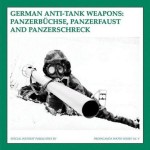
German Anti-Tank Weapons: Panzerbüchse, Panzerfaust and Panzershreck, again by de Vries and Martens, is Volume V in the series and covers the German infantry anti-tank weapons of World War II. It actually begins with the World War I anti-tank rifle, the Mauser Tankgewehr, and also introduces the interwar weapons of foreign nations that drew inspiration from it, including the British Boys AT rifle and the Polish Wz.35. Germany’s Panzerbüchse 39 and its Soviet counterparts are covered. These AT rifles quickly became obsolete as tanks grew harder armor, forcing the development of Munro Effect shaped-charge weapons. The two principal weapons were the Faustpatrone and Panzerfaust series of expendable self-launching grenades, and the Panzershreck which was an improved copy of the US M1 Anti-tank Rocket Launcher (“Bazooka”). This book has enough information for the collector or hobbyist to understand and identify these weapons. (The book Desperate Measures cited above has more on the development of the hollow-charge weapons)
These books were enough of a hit — particularly the K98k one — that we’ll be getting more of this series. But we’ll be buying them smart.
What does that mean?
Buying the Books without Breaking the Bank
- By signing up for updates from Small Arms of the World, we also get periodic promotions on books from their affiliated store, Long Mountain Outfitters.
- By haunting Amazon for discounted copies. Amazon itself usually beats the regular price from the SAotW bookstore, but not the weekly specials. But Amazon also acts as an interface for a network of small booksellers. These guys can often hook you up at a reasonable price.

Kevin was a former Special Forces weapons man (MOS 18B, before the 18 series, 11B with Skill Qualification Indicator of S). His focus was on weapons: their history, effects and employment. He started WeaponsMan.com in 2011 and operated it until he passed away in 2017. His work is being preserved here at the request of his family.

